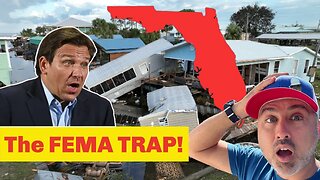Premium Only Content

No safe spaces (2019)
This video is about the gradual loss of our freedom of speech Who decides what is considered hate speech?
The victimization of a people does not give permission for genocide.
The Jewish misrepresentation of that really happened during the so called holocaust.
The Zero Trust model, a revolutionary concept in cybersecurity, operates on the principle that no one inside or outside the network is trusted by default. Introduced in 2010, Zero Trust challenges the traditional security model of 'trust but verify' by adopting a 'never trust, always verify' approach.
This model requires strict identity verification for every person and device trying to access resources on a private network, regardless of whether they are sitting within or outside of the network perimeter.
Zero Trust architecture minimizes the risk of data breaches by limiting access to only what is needed and constantly validating that trust.
Zero trust closes the end-user gap in cybersecurity
Organizations go beyond passwords to embrace a new approach to defending against cyberattacks.
Closing the IT Security Gap: The State of Zero Trust and SASE Security Architectures in 2023
Increased hybrid work, growing use of IoT, and relentless
cyberattacks all add up to greater security challenges facing
organizations than ever before.
New challenges are prompting
the adoption of new security models. Zero Trust and SASE
(Secure Access Service Edge) architectures hold the promise of
https://www.arubanetworks.com/assets/infographic/Ponemon-Closing-IT-Security-Gap_Infographic.pdf
The State of SD-WAN, SASE and Zero
Trust Security Architectures
https://www.arubanetworks.com/assets/Aruba-Ponemon-Report-2021.pdf
In May 2021, President Joe Biden's Executive Order on Improving the Nation's Cybersecurity outlined a goal for federal agencies to implement zero-trust security. Since then, MIT Lincoln Laboratory has been performing a study on zero-trust architectures, with the goals of reviewing their implementation in government and industry, identifying technical gaps and opportunities, and developing a set of recommendations for the United States' approach to a zero-trust system
https://news.mit.edu/2022/zero-trust-architecture-may-hold-answer-cybersecurity-insider-threats-0517
HOMELAND PROTECTION
DEVELOPING TECHNOLOGY TO KEEP THE NATION SAFE
https://www.ll.mit.edu/r-d/homeland-protection
Executive Order on Improving the Nation’s Cybersecurity
Towards Zero Trust For Critical Infrastructure:
Rethinking The Industrial Demilitarized Zone
https://courses.csail.mit.edu/6.857/2020/projects/2-Boumhaout-Danielsen-Pedersen-Shahid.pdf
The National Institute of Standards and
Technology (NIST) published a Guide to Industrial Control
Systems Security
https://nvlpubs.nist.gov/nistpubs/SpecialPublications/NIST.SP.800-82r2.pdf
What's the state of Zero Trust security? - CIO
Jun 28, 2023Zero Trust adoption is accelerating, with over half of organizations reporting they have adopted Zero Trust Security, according to research independently conducted by leading security research .
https://www.cio.com/article/643767/whats-the-state-of-zero-trust-security.html
Private Automated Contact Tracing
https://www.ll.mit.edu/r-d/projects/private-automated-contact-tracing
The Smart Approach To Implementing Zero-Trust Security: Building To SASE
Zero Trust Architecture: Rethinking Cybersecurity for Changing Environments
Zero Trust Architecture (ZTA) is not something you buy.
It is an architectural approach—a way of thinking about cybersecurity which posits that traditional perimeter defenses aren't enough and cannot suffice to create a zone of trust in your network.
Every asset in the environment should be protected, and every connection starts with Zero Trust.
Trust must be earned on the basis of a risk-based access decision before each and every connection is allowed.
Additionally, this trustworthiness must be continuously verified to maintain the connection.
This article defines Zero Trust, identifies its characteristics, and provides strategies to start using a Zero Trust approach in your organization.
Why the Need for Zero Trust?
The border to the modern network is no longer clear:
Users are logging in from home,
from coffee shops and other public Wi-Fi, and from locations all over the world.
All kinds of devices need to connect, including laptops, mobile devices, and Internet of Things (IoT) devices.
Data and applications are no longer solely in an institution's data center but are located in multiple public, private, or hybrid clouds.
Timeline of Zero Trust
2003: The Jericho Forum, a group of interested chief information security officers (CISOs), is formed to discuss what they called the de-perimeterization problem.
2010: John Kindervag, then a Forrester Analyst, popularized the term "Zero Trust" and recommended treating every asset as if it were connected directly to the risk-infested internet. Therefore, all connections are untrusted.
2014: Google published whitepapers and other guidance on their model implementation of Zero Trust, called BeyondCorp.
2017: Forrester, led by Chase Cunningham, refined its original Zero Trust guidance, calling it Zero Trust eXtended.
2017: Gartner introduced its version of Zero Trust, calling it Continuous Adaptive Risk and Trust Assessment, or CARTA.
It included a similar focus on access control and added a focus on protecting the enterprise from threats.
2020: NIST released its definition in "Special Publication 800-207: Zero Trust Architecture."Footnote2
2021 to today: The industry has largely accepted the idea of Zero Trust and ZTA as the term for it. Zero Trust has become a buzzword, often used incorrectly.
Defining Zero Trust
Forrester is widely credited with popularizing Zero Trust and the follow-on, Zero Trust eXtended (ZTX).Footnote3 Several basic principles of Zero Trust are:
The network is always hostile.
Internal and external threats are always present.
Being on an internal network is not sufficient to be trusted.
Every device, user, and network flow must establish trust before connecting.
All events must be logged and inspected.
H.R.2969 - Financial Technology Protection Act of 2023
https://www.congress.gov/bill/118th-congress/house-bill/2969
GOOGLE GETTING RID OF PASSWORDS
https://www.youtube.com/watch?v=l52-pueiyw4
No more passwords? Google looks to make passwords obsolete with passkeys
https://www.msn.com/.../no-more-passwords.../ar-AA1i6dLE
INTERNET FOR ALL Digital Equity Plan
Guidance
mit and dod are implementing zero trust biometric id to use internet by 2027 they also have the restrict act they can take down any website they want
Five-Year Action Plan and State Digital Equity Plan Alignment
The Broadband Equity, Access, and Deployment (BEAD) Program was authorized by the
Infrastructure Investment and Jobs Act of 2021 (November 15, 2021),
also known as the
Bipartisan Infrastructure Law.
BEAD provides $42.45 billion to expand high-speed internet
access by funding planning, infrastructure deployment, and adoption programs in all 50 states,
Washington D.C., Puerto Rico, the U.S. Virgin Islands, Guam, American Samoa, and the
Commonwealth of the Northern Mariana Islands.
It is anticipated that each Eligible Entity participating in the BEAD Program will concurrently
participate in the State Digital Equity Planning Grant Program, and in many of the 13
requirements of the BEAD Five-Year Action Plan, there are opportunities to infuse digital
inclusion activities to both satisfy requirements of the State Digital
Equity Plan and ensure that
digital inclusion is a core component of broadband planning.
https://broadbandusa.ntia.gov/sites/default/files/2022-09/Digital_Equity_Plan_Guidance.pdf
Sen. Cruz Leads Senate Republicans in Calling on FCC to Halt ‘Digital Equity’ Plan
The Honorable Jessica Rosenworcel
Chairwoman
Federal Communications Commission
45 L Street N.E.
Washington, D.C. 20554
Dear Chairwoman Rosenworcel
https://www.commerce.senate.gov/services/files/25A46EEF-7441-460C-9C23-2C9121A6BBDD
Metaverse, Me and Web3: Exploring the BioDigital Convergence.
Web3: is the next version of the internet, designed to allow for more control over data and interactions online.
Blockchain: is a record of data stored across many computers.
(IoT)/(IoB): ‘Internet of Things’ / ‘Internet of Bodies’: is the inter-connected ecosystem of everyday objects and human bodies connecting online, allowing the exchange and collection of data.
Digital Twin: is a virtual replica or representation of a physical object, system, or process that allows real-time monitoring, analysis, and simulation.
(CBDC): ‘Central Bank Digital Currency’: is a digital form of currency, regulated by a central bank.
Digital ID: is a collection of electronically captured and stored identity attributes, including biographic data (e.g. name, age, gender and address) and biometric data (e.g. fingerprints, iris scans and facial photographs).
Health Passport: is a digital certificate that shows an individual's health information.
Biometrics: are the biological measurements or physical. characteristics that can be used to identify individuals.
Surveillance: involves the acquisition, processing, analysis, use, retention and storage of information about large numbers of people.
(BMI): ‘Brain Machine Interface’: is a technology that connects the human brain with external devices, enabling communication between the brain and machines.
is a technology that connects the human brain with external devices, enabling communication between the brain and machines.
(NFT): ‘Non-Fungable Tokens’: are unique digital assets, that hold value in the digital world.
are unique digital assets, that hold value in the digital world.
(5G)/(6G): are the next generations of telecommunications infrastructure, enabling faster wireless data transfer(uploads + downloads) and more advanced devices to be connected.
Carbon Credit: is a certificate representing a positive action to reduce greenhouse gas emissions, earned by individuals or companies to offset their carbon footprint.
Social Credit: is a scoring system that evaluates then scores individuals and their digital twins based on behaviors and actions in society, determining their reputation and privileges.
(AR)/(VR): ‘Augmented Reality’ / ‘Virtual Reality’: (AR) overlays digital content onto the real world, while (VR) provides a simulated and interactive virtual environment.(AR) overlays digital content onto the real world, while (VR) provides a simulated and interactive virtual environment.
United Nations Proposes Digital ID System Tied to Bank Accounts and Mobile Payment Platforms
Metaverse identity encompasses three components:
Representation: including personal, social and role identity,
be it through avatars, pseudonyms or other digital expressions
Data: capturing the intricate web of knowledge about individuals generated
by metaverse supporting hardware and software
Identification (ID):
be it through driver’s licenses, government-issued IDs, passports, birth certificates, attestations, labels, or usernames and passwords
Congress explores digital identity schemes, WEF-backed public-private collaboration agenda
https://sociable.co/government-and-policy/congress-digital-identity-wef-public-private-agenda/
The US House of Representatives explores digital identity schemes and hears testimony in favor of public-private collaboration on biometric ID authentication standards championed by the World Economic Forum and the FIDO Alliance.
The World Economic Forum (WEF) is pushing digital identity as a major component of its globalist great reset agenda to revamp the world’s economy and all societal structures.
“The public and private sectors should collaborate to deliver solutions that promote confidence, privacy, choice, and innovation” — “Improving Digital Identity Act of 2021”
In January, 2020, the WEF partnered with the FIDO Alliance on a 26-page report called “Passwordless Authentication,” in which the two entities presented how digital identity could be authenticated using FIDO’s biometric principles.
FIDO, which stands for Fast IDentity Online, developed an authentication standard that looks to eliminate the need for passwords and replace them with a user’s biometric identifiers through voice and facial recognition, iris scans, and fingerprint swipes.
Testifying on digital identity before Congress on Friday was one of the joint WEF-FIDO report contributors, Jeremy Grant, who is also the managing director at Venable — a WEF partner on the Platform for Good Digital Identity.
WEF_Passwordless_Authentication.pdf
https://www3.weforum.org/docs/WEF_Passwordless_Authentication.pdf
KEY INSIGHTS FROM THE REPORT
The Evolution and Importance of Digital ID:
The report traces the history of identification and its pivotal role in society, emphasizing the need for digital ID in an era where digital transactions and AI are becoming ubiquitous. It discusses various forms of digital ID, including centralized, federated, and decentralized systems, each with unique advantages and challenges.
Decentralized ID – A Paradigm Shift: Decentralized ID systems, leveraging cryptography and digital wallets, empower individuals to manage their data while allowing multiple entities to issue credentials.
This approach enhances privacy, control, and efficiency, and is seen as a potential game-changer in the digital ID landscape.
Challenges and Recommendations:
Despite its potential, decentralized ID faces implementation barriers, including technical complexities, policy gaps, and governance challenges.
The report provides comprehensive recommendations for stakeholders, emphasizing the need for technological innovation, policy development, and collaboration to realize the full potential of decentralized ID.
While the report primarily focuses on the broader research project of decentralized ID,
it acknowledges the contributions of various stakeholders, including organizations like the Learning Economy Foundation.
The Foundation's role in supporting these efforts, particularly in the context of educational and skill credentials, is crucial.
Decentralized ID can enable verifiable, efficient, and private proof of educational achievements, aligning with the Foundation's mission of fostering a learning economy.
"Reimagining Digital ID" by the World Economic Forum is a significant contribution to the ongoing discourse on digital identity. It not only highlights the challenges faced by millions without legal IDs but also proposes decentralized ID as a viable solution to enhance privacy, control, and access to services.
The report's recommendations offer a roadmap for stakeholders, including the Learning Economy Foundation, to navigate the complexities of implementing decentralized ID systems effectively.
World Bank president calls on governments to launch digital ID, connect with private sector
https://sociable.co/government-and-policy/world-bank-governments-digital-id-connect-private-sector/
Reimagining Digital ID
INSIGHT REPORT
JUNE 2023
https://www3.weforum.org/docs/WEF_Reimagining_Digital_ID_2023.pdf
Netherlands Promotes Digital ID At Davos - Armstrong Economics
https://www.armstrongeconomics.com/world-news/wef/netherlands-promotes-digital-id-at-davos/
Reimagining Digital ID: A World Economic Forum Insight Report
https://www.learningeconomy.io/post/reimagining-digital-id-a-world-economic-forum-insight-report
UN pushes for global digital ID system to boost financial inclusion
https://dig.watch/updates/un-pushes-for-global-digital-id-system-to-boost-financial-inclusion
Davos 2023: What To Know About WEF's Digital ID Initiative To Reduce Poverty, Increase Global Productivity
Your metaverse identity will be central to daily life: WEF report
Virtual voodoo dolls, autonomous avatars & digital doppelgangers will be your behavior-profiling passports in the metaverse: perspective
Your metaverse identity, with its digital ID, biometric data capture, and behavior profiling, will be central to your every day life, according to a World Economic Forum (WEF) report.
“Metaverse identity” is a relatively new concept that the WEF and Accenture describe in great detail in a new 48-page report entitled “Metaverse Identity: Defining the Self in a Blended Reality.”
According to the report:
“As people spend more time exploring, playing and socializing in digital experiences, a person’s metaverse identity will be central to their day-to-day life as well as to the way they express their personal identity.”
But what exactly do the unelected globalists mean by “metaverse identity?”
https://sociable.co/government-and-policy/metaverse-identity-central-daily-life-wef/
great reset
https://sociable.co/tag/great-reset/
‘Internet of Bodies may lead to Internet of Brains’ by 2050: Rand
“An ‘internet of bodies’ may also ultimately lead to an ‘internet of brains’, i.e. human brains connected to the internet to facilitate direct brain-to-brain communication and enable access to online data networks”
Commissioned by the UK Defence Science and Technology Laboratory and conducted by RAND Europe and Frazer Nash Consulting, the study “Cultural and technological change in the future information environment” looks at six technologies and information environments and their implications for British defense.
They include:
Automated information systems
A virtual metaverse
Augmented and mixed reality
Advanced connectivity
Human augmentation
Information security
A major theme running through these information environments is transhumanism — the merger of humans and machines.
“While some experts predict the tactical improvement of human capabilities, others have explored the potential emergence of ‘trans-humanism’ within the 2050 timeframe”
RAND Corporation, March 2024
https://sociable.co/military-technology/internet-of-bodies-internet-of-brains-2050-rand/
Cultural and technological change in the future information environment
https://www.rand.org/pubs/research_reports/RRA2662-1.html
Your digital identity can be used against you in the event of a great reset
https://sociable.co/technology/your-digital-identity-used-against-you-great-reset/
Metaverse Identity:
Defining the Self in
a Blended Reality
INSIGHT REPORT
MARCH 2024
https://www3.weforum.org/docs/WEF_Metaverse_Identity_Defining_the_Self_in_a_Blended_Reality_2024.pdf
original found on unscr
-
 18:19
18:19
Watchman's Duty
18 days agoIs Florida becoming Unlivable?! (What they are not telling you!)
5.03K7 -
 LIVE
LIVE
Candace Show Podcast
1 hour agoMatt Gaetz Out, Jussie Smollett Walks Free! | Candace Ep 108
10,848 watching -
 LIVE
LIVE
Tate Speech by Andrew Tate
9 hours agoEMERGENCY MEETING EPISODE 92 - IN THE TRENCHES
97,110 watching -

In The Litter Box w/ Jewels & Catturd
21 hours agoThe Trump Effect | In the Litter Box w/ Jewels & Catturd – Ep. 696 – 11/21/2024
13.5K12 -
 20:53
20:53
SLS - Street League Skateboarding
2 days agoGold Medals, World Class Food, Night life & more - Get Lost: Tokyo
1.29K -
 47:13
47:13
PMG
17 hours ago"Hannah Faulkner and Doug Billings | WHY LIBERALS LOST THE ELECTION"
1.21K -
 59:01
59:01
The Liberty Lobbyist
3 hours ago"We Only Have NOW To Make a Difference"
1401 -
 4:16:41
4:16:41
CatboyKami
4 hours agoStalker 2 Blind playthrough pt1
551 -
 1:06:27
1:06:27
Russell Brand
5 hours agoNeil Oliver on the Rise of Independent Media, Cultural Awakening & Fighting Centralized Power –SF498
171K230 -
 1:39:14
1:39:14
vivafrei
5 hours agoSoros Karma in New York! Tammy Duckwarth Spreads LIES About Tulsi Gabbard! Pennsylvania FLIPS & MORE
80.1K60